We’re starting off the New Year with something from the old year. I bought the TreadTracker a year ago, and I’m finally getting around to posting about it. Fear not, what’s old is new again. And, for many of you mid-winter, what’s old is still very relevant (since there’s nothing else like it).
The TreadTracker is essentially a Bluetooth Smart footpod that doesn’t require a foot. Instead, it sits below your treadmill and has a smaller roller wheel that tracks your treadmill’s pace and transmits it as a Bluetooth Smart footpod sensor that any app (like Zwift) can pick up and utilize. The main reason to use something like this is that it’s ‘set it and forget it’, or if you have multiple people using a treadmill. Whereas a footpod is certainly more portable (such as while travelling), but some may require calibration and frequent charging. Plus there’s the question of accuracy. But fear not, we’ll get to that.
Oh will we ever! I’ve spent probably 8+ hours today alone on looking into accuracy, and in particular, accuracy of my treadmill and other methods to validate that. It’s now 1:30AM though, and I’ve satisfied the itch that I stumbled upon this morning. So come along on that journey.
Now if you’d like this entire review in one nifty video – then go no further than the play button below:

Else, onwards with the photos and text and plenty of data!
What’s in the box:
The box is pretty straightforward, which I like. Here’s the outside:
Inside, you’ve got the unit protected by some plastic. Take it out and you’ve got the unit, some paper stuffs, and a mini-USB cable for power/charging. Oddly however, you don’t have a USB to power outlet adapter. Given this is something that’s somewhat designed to be plugged in permanently, it seems like a quirky oversight. No worries, I have plenty.
Here’s the manual. It’s pretty straightforward, we’ll talk more about how to use it in a second.
And that’s all there is in the box. Not much more to say here. Let’s get into using it.
The Basics:
This device is silly simple to use, so I’m going to try and keep this efficient. I’ll still probably fail at doing so.
The TreadTracker is designed to be placed below your treadmill such that it snuggles up against the belt, measuring the speed of the belt using the small roller wheel at the top of the TreadTracker.
However, a key part of that snuggling bit is ensuring it can adapt to different treadmill heights, and ensuring that it keeps a tight fit to the belt while doing so. So the entire unit comes ‘locked’ by default, which means that it’s lying flat like this:
However, on the bottom there’s a little lock latch. Once you unlock it, the unit pops up:
It’s on a spring, so if it ‘hits’ your treadmill belt before it reaches its peak – then that’s all fine. If however after the first un-popping it’s still not long enough you can extend it again:
The minimum clearance you need under your treadmill is 7cm, and the max it can handle is 21cm. Here it is sitting under my treadmill:
On the face of it there’s two lights:
Blue Light: Bluetooth Smart Status light
Other Light: Battery indicator
That battery indicator has three status levels within it:
Green: Battery above 50%
Orange: Battery less than 50%
Red: Battery less than 10%
The unit should be charged with a 1AMP USB plug (most plugs will be close enough to cover this, or slow charge it at worst).
Meanwhile, on the bottom there’s the lock for the arm:
However, there’s also a small plate that extends out and allows the unit to rotate slightly and pivot. This is actually kinda cool and is notable in case there’s any unevenness.
When it comes to placement of the unit, the company recommends the center of the treadmill in their manual:
However, online in their FAQ section it says it doesn’t matter, as long as it makes contact with the belt. I tried both positions and tested accuracy for both and found no difference. So for me, I prefer the back because then I can easily see/check the status lights if need be.
Note that you do NOT need to use the RunSocial app at all – ever. Not once. However, if you do download the app, you can actually customize the broadcasted Bluetooth Smart name. This would be useful if you had multiple units and wanted to name them (e.g. ‘Treadmill 1’, ‘Treadmill 2’, etc…)
Most of you will be using TreadTracker with Zwift running (or some other indoor app, I suppose). To get it configured there you’ll simply open up the run pairing screen and then select the TreadTracker from the list:
And…you’re done.
Seriously, it’s that easy.
Note that Zwift will automatically pair to the cadence channel from the TreadTracker, but in reality the TreadTracker doesn’t transmit cadence (it’s just part of the BLE footpod spec, so TreadTracker conforms to it). Thus, if you have some other thing that’ll transmit running cadence, you’ll want to select that for cadence.
Simply pair to your HR strap if you have one and you’re off and running (literally):
Your pace will be displayed automatically in the app, based on the speed of the belt of your treadmill. In an ideal world, that’d match the actual speed on the treadmill, but that’s an entirely different ball of wax that I’ll cover in the next section.
Reaction time is virtually instant in my experience – super quick. In fact, you can see it’s a slight bit faster than Stryd is, if you overlay the two charts together. Here it is against the treadmill as well. Now, the accuracy isn’t good on this treadmill as I discovered, but you can see at least how quickly it responds in the intervals:
Zwift aside, what’s cool here is that it’s a standard Bluetooth Smart footpod. So it’ll work (in theory) with any Bluetooth Smart footpod capable device. For example, I successfully paired it up to my Garmin Fenix 5 Plus to get pace/distance into that, while that was attached to the treadmill:
Sure, I could have worn the watch and got a rough approximation, but that doesn’t often handle things like dorking with treadmill speed or drinking from a bottle (or wiping sweat) very well.
While I haven’t tested it with other devices/apps, it should also work with both Polar and Suunto watches as well.
In any case, the key message here is that it ‘just works’. There’s almost nothing to do except run on your treadmill and have it transmit pace and thus distance. Again, no cadence however.
Accuracy Testing:
It’s funny, accuracy testing this device should be easy. But in reality, it’s anything but. There’s a surprising number of ways things can differ, and more importantly – a hilarious number of ways it can go horribly wrong. I’ve taken the assumption that my treadmill may not be accurate. That’s usually a good assumption to make. If you’ve done any amount of treadmill running at gyms and hotels you likely know how different they can be. Even two identical treadmills side by side in a gym are somehow significantly different in pace (and thus distance).
My treadmill is about 3-4 years old, though it doesn’t actually have a ton of mileage on it. Almost all of my running is outdoors, and so my guess is that this treadmill only has about 80 miles on it. Not much (which usually drives the accuracy side of the equation). Before doing these tests, I calibrated the treadmill per the manufacturer’s instructions.
So, I set about trying to validate it, and thus by extension the TreadTracker.
Do to that I’ve got three validation sources. I’m not necessarily claiming that any of these devices is a known ‘good’, but, it’s just four devices to work from.
1) Orange Measuring Wheel (This one): This is specifically designed for measuring courses (orange one)
2) Yellow Distance Tracker: This isn’t so much designed for measuring running courses, but just distance (yellow one)
3) TreadTracker: The thing this entire post is on
4) ProForm 1250 Treadmill: My crappy treadmill
Invariably someone will say ‘Get a Jones Counter bike!’, and sure, that’d be nice. But that also presents the slight challenge of putting it on a treadmill. I could also leverage other magnet-based sensors as well to measure and place that bike on the treadmill somehow. But I think I’ve got enough sources.
Of course, then there’s the mother of all sources: Math
Ironically, the subject I hated the most in school. And no, I still haven’t had any use for calculus in my life yet.
In order to math this out I had to do some measuring on my treadmill and paint out some lines. I started off with a ‘0’ (zero) marker and then painted a line every 1 meter.
I had no idea how long the belt would be, but turns out my arts and crafts project was short-lived. The belt was exactly three meters long. So I had a ‘0’, ‘1’, and ‘2’ lines. I then put another line on the other side of the treadmill at the ‘0’ marker so I could easily see it and count it.
Then, I simply turned on the treadmill to a lowish speed, 3KPH, so I wouldn’t miss any lines as they went by, and then counted them. I used a random free counter app off the app store:
Because I got bored of counting lines quickly, I decided to simply go for 34 lines. I was going to do 33 rotations, but then I couldn’t get it stopped fast enough, so 34 it was. Or 102 meters worth (each rotation is three meters). While my orange and yellow counters measure in feet/inches, I converted them to meters to keep things sane here. When the marker line went past the marked starting point, I measured the ‘extra’ distance and added it in. And thus, the results:
Math Distance: 102.3 meters (true distance)
TreadTracker via Zwift: 100.0 meters*
Orange Counter: 101.83 meters
Treadmill: 111 meters
Now, there was a slight problem there. Zwift only shows me the distance in increments of 1/10th of a kilometer. For example. .11 kilometers, .12 kilometers, etc… Meaning a gap 10 meters. Too high for what I wanted.
So I found a Garmin Connect IQ app for my watch that would show me straight meters (up to 1-kilometer), so it would show me exactly 101 meters, etc… Perfect. I paired the Fenix 5 Plus up to the TreadTracker as a Bluetooth Smart footpod and then did the test again:
Math Distance: 102.9 meters (true distance)
TreadTracker via watch: 100.0 meters
Orange Counter: 103.0 meters
Treadmill: 106 meters
Ok, getting closer.
Now before that, I had done some 1KM in length tests. Except at this point it’d take a lot of waiting and likely screwed up counting to get the marks counted. So instead I went with just these three sources. Here’s round #1 where I slowed to a crawl and then stopped the treadmill at precisely the moment Zwift showed 1.00KM.
TreadTracker via Zwift: 1000 meters
Orange Counter: 1027.4 meters
Treadmill: 1057 meters
And, for fun, I did it again. Both of these tests were done at 10KPH (to reduce chances of belt slippage on the counters which I found starts to happen above those speeds):
TreadTracker via Zwift: 1000 meters
Orange Counter: 1029.8 meters
Yellow Counter: 1024.9 meters
Treadmill: 1056 meters
Ok, so at this point I’d summarize things as follows:
1) The treadmill is definitely off, by roughly 2.5% to 5%, usually reading faster than it is
2) The two roller counters are really darn close to each other
3) The TreadTracker is very close when using Zwift to record (within 1.0-2.0% total distance)
4) The TreadTracker is even closer (within 2.5% matching the counters when using the Garmin watch to record)
So why the slight variance between using a Garmin and Zwift? I suspect it has to do with either dumb luck, or some aspect of how precisely Zwift counts, especially when the unit first starts and stops. Keep in mind we’re talking distance here that are relatively small (1KM tests).
Thus, let’s increase the distance. This time I went with a longer run, a structured workout on Zwift with paces all the way up to 15.6KPH. It looks like this:
Now, there was one failure during this test. After the very last interval during the cool-down Zwift and TreadTracker randomly stopped talking. Zero pace displayed. I ended up rebooting the TreadTracker and that solved it. I haven’t ever seen this before. So there was about 10-20 seconds (at 10KPH) that I was trying to figure out what the heck was going on, and thus the Zwift/TreadTracker and Stryd total would be reduced by 10-20 seconds worth by the time I got everything stopped. Nonetheless, here’s those totals for the fun of it:
Stryd: 7.91KM
TreadTracker: 7.92KM
ProForm: 8.36KM
Here however are the totals if I snip to the point prior to the dropout:
Stryd: 7125.87m
TreadTracker: 7172.31m
ProForm: 7319.29
Here’s how that looks from a pace overlay standpoint in the DCR Analyzer:
And here’s how that looks if I plot distance over time.
Interestingly, one thing I clearly noticed in my faster intervals (thus above about 14.5KPH/9MPH which is 4:10/KM or 6:40/mi), is that the treadmill actually surges faster even though the speed on the treadmill remains the same. I can audibly hear the motor surging, my legs surging, and then the TreadTracker and Stryd footpods surging. Meanwhile, the treadmill itself does the equivalent of ripping a silent but deadly fart in the middle of a packed conference room, without admitting it. It plots the same pace, even though it surges from 14.5KPH up to about 15.1KPH (3:58/KM or 6:23/mi):
So what’s my total accuracy round-up here? I like bulleted lists, they’re simple:
A) My treadmill isn’t super awesome (which, I already knew in general, but this confirms it)
B) The counter wheels bungee corded to my treadmill are surprisingly good at accuracy
C) The TreadTracker is within 1-2% in most cases of math, and seems to respond very quickly to pace changes
I’m looking forward to trying this with the rebranded $29 Zwift (Milestone) Running Pod when I grab it next week. I have an earlier Milestone pod I’ve long used, but I figured I’ll test out the newly rebranded version. I’ve got one I ordered that should show up next week.
Side note: No, I don’t plan on making a habit of reviewing treadmills (and this would not be a review of my treadmill, though I’ve noted many times I dislike it). I might do others if there’s some unique to market treadmill that shows great interest from readers. But for the most part, I don’t terribly enjoy running on treadmills, so it’s gotta be something that’s totally different and thus appealing in some new way.
Another note: All of the charts in these accuracy portions were created using the DCR Analyzer tool. It allows you to compare power meters/trainers, heart rate, cadence, speed/pace, GPS tracks and plenty more. You can use it as well for your own gadget comparisons, more details here.
Wrap-up:
In some ways the best question about this is actually more like who’s it for?
For many people, it might be easier to just pick up a footpod and have it always on their shoe. That way if they’re out traveling the world, it’ll give them mostly accurate pace/distance no matter what treadmill they’re on. Certainly a coin-sized footpod is easier to travel with than this nearly shoe sized device.
But footpods aren’t quite as stable as some people think they are. They’re often prone to slight tweaks in pace based on shifts in cadence or even running style/efficiency. Sure, those like Stryd are quite good – but they’re not perfect. Same goes for the Milestone/Zwift pod. Of course, Stryd is $199, and the Zwift pod a mere $29. Obviously Stryd’s pod does power and other things, but most people don’t care about that.
The appeal of the TreadTracker is that it’s set it and forget it, especially for those with more than one person using it. For example, The Girl and I using the treadmill. In this case it just sits there below the treadmill and available for use for whoever jumps on – zero calibration needed. Heck, the name even looks like it’s the treadmill.
Will it make sense for everyone? No, of course not. But I actually like the idea. I’m very much a ‘set it and forget it’ kind of person. I want to jump on and not worry about whether or not my footpod is properly calibrated (or charged). It has a high ‘just works’ factor.
With that – thanks for reading!
FOUND THIS POST USEFUL? SUPPORT THE SITE!
Hopefully, you found this post useful. The website is really a labor of love, so please consider becoming a DC RAINMAKER Supporter. This gets you an ad-free experience, and access to our (mostly) bi-monthly behind-the-scenes video series of “Shed Talkin’”.
Support DCRainMaker - Shop on Amazon
Otherwise, perhaps consider using the below link if shopping on Amazon. As an Amazon Associate, I earn from qualifying purchases. It doesn’t cost you anything extra, but your purchases help support this website a lot. It could simply be buying toilet paper, or this pizza oven we use and love.

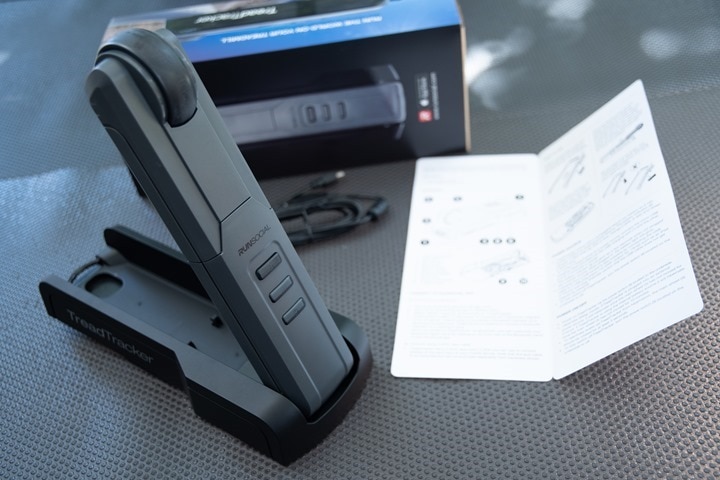

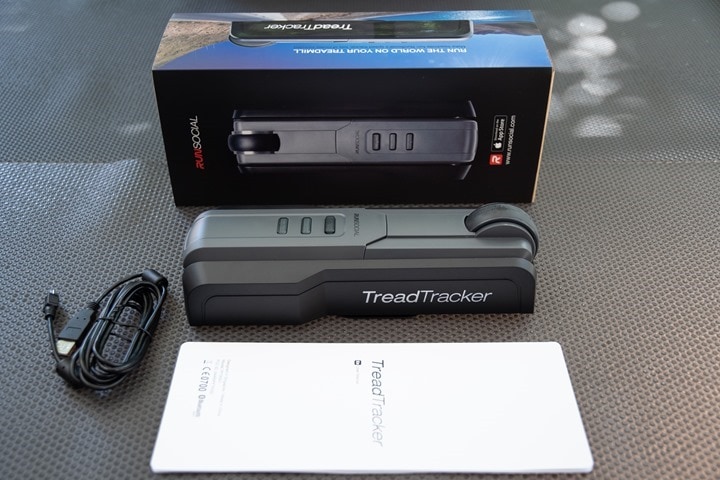
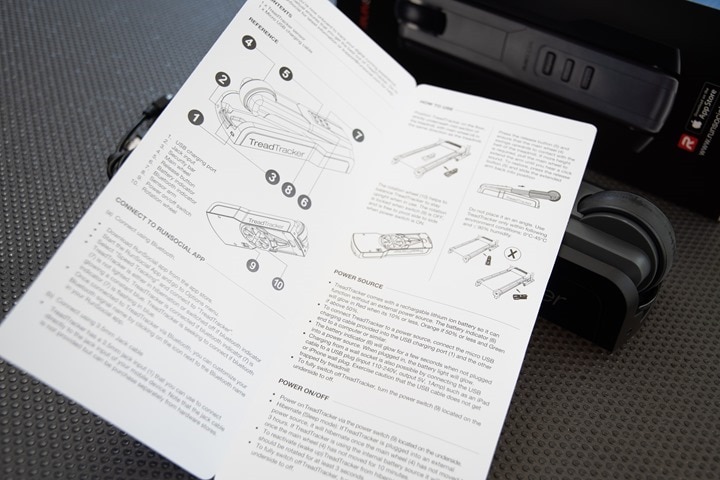

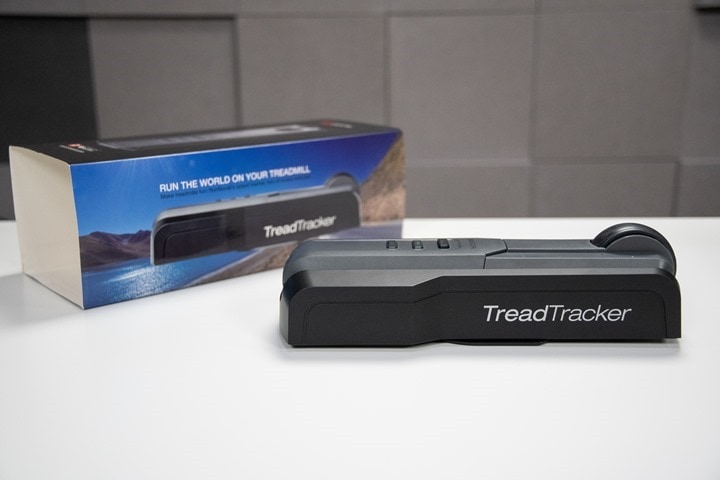
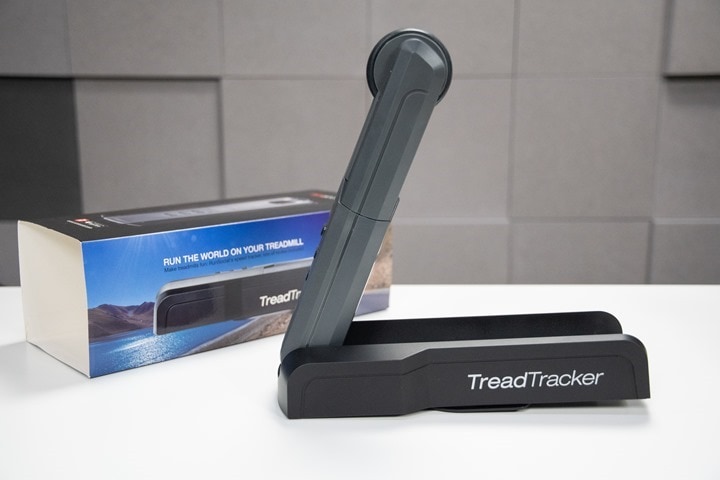
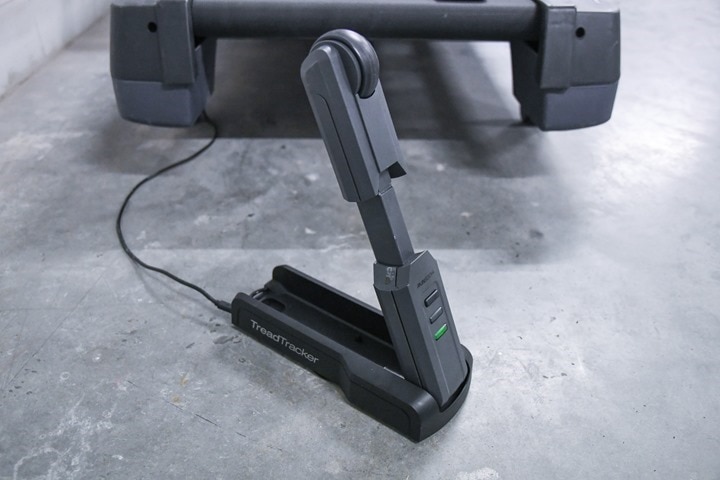
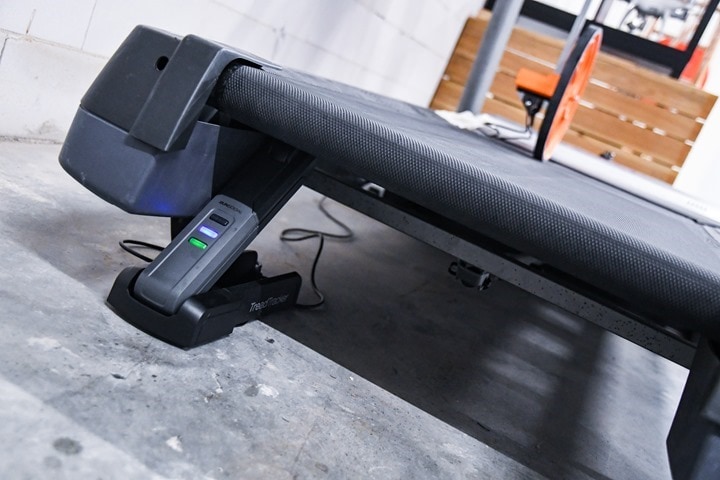
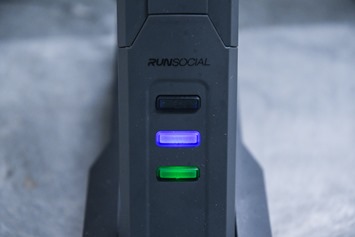
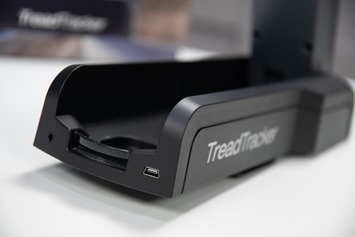
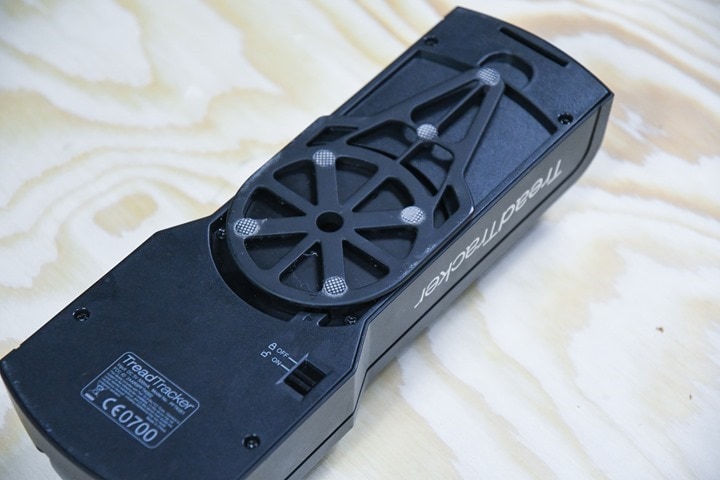
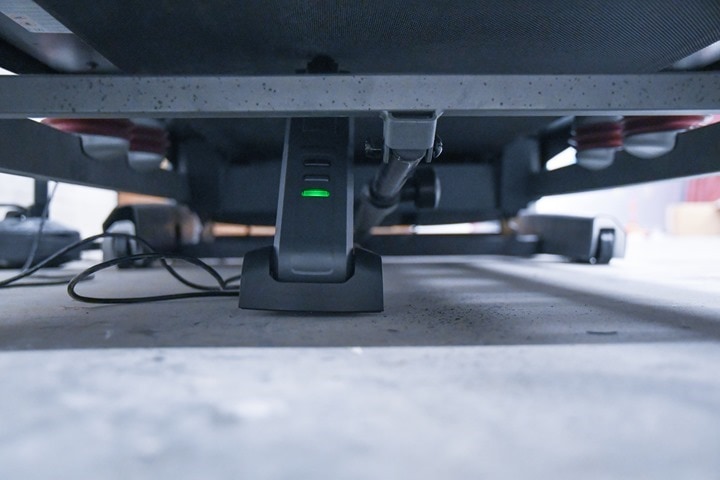

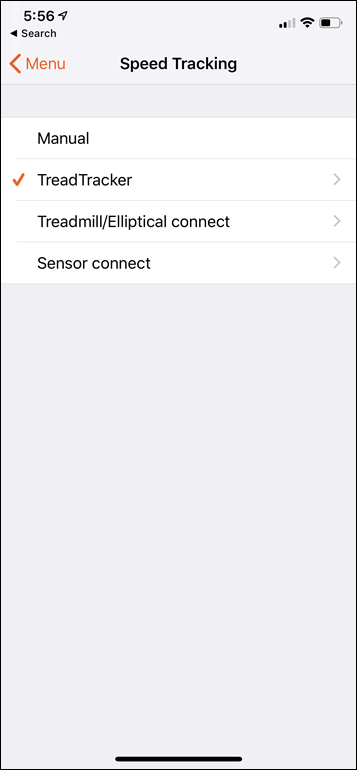
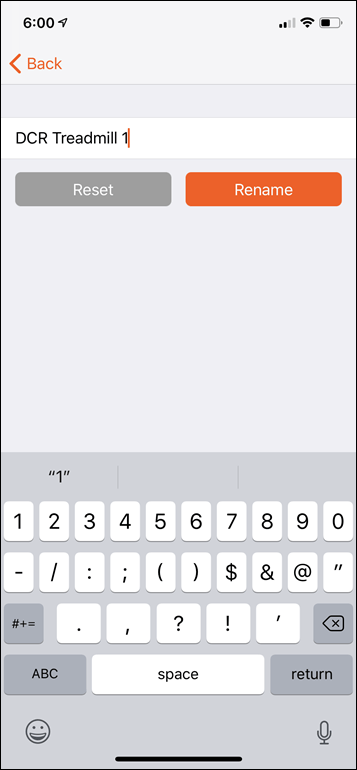
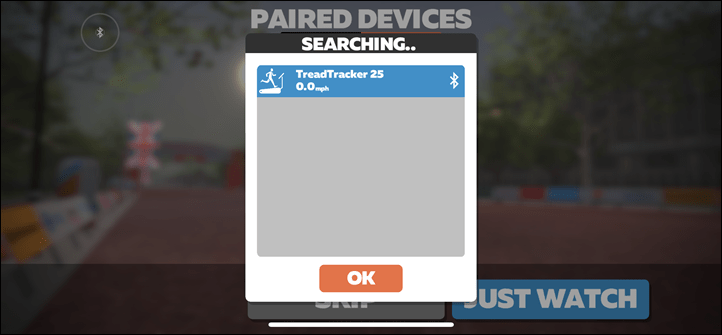
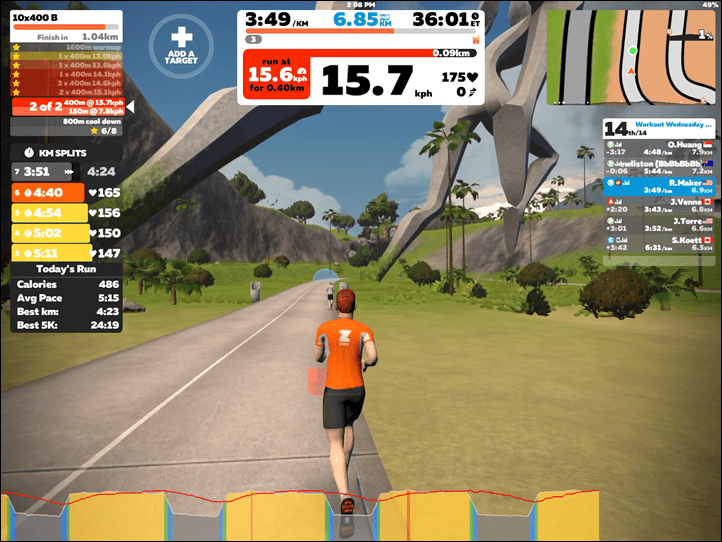

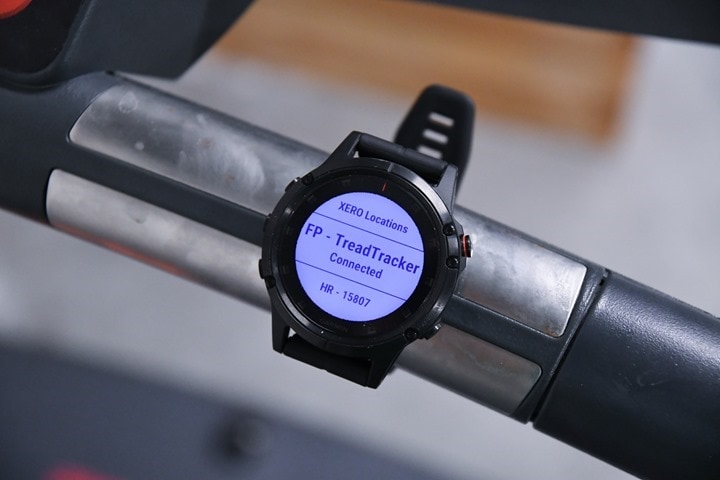
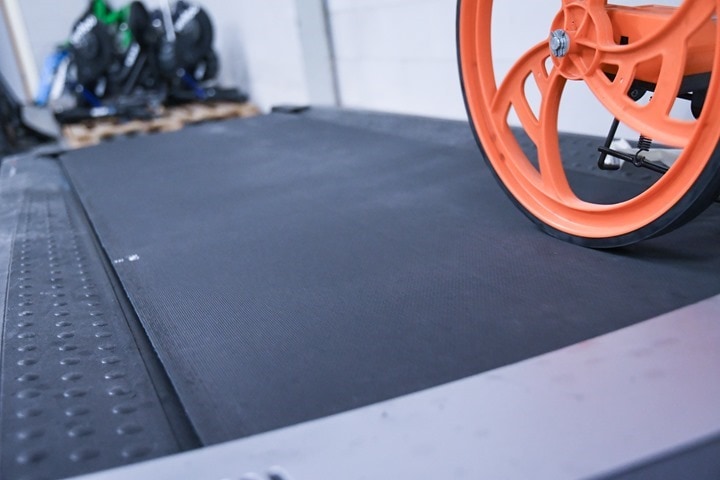
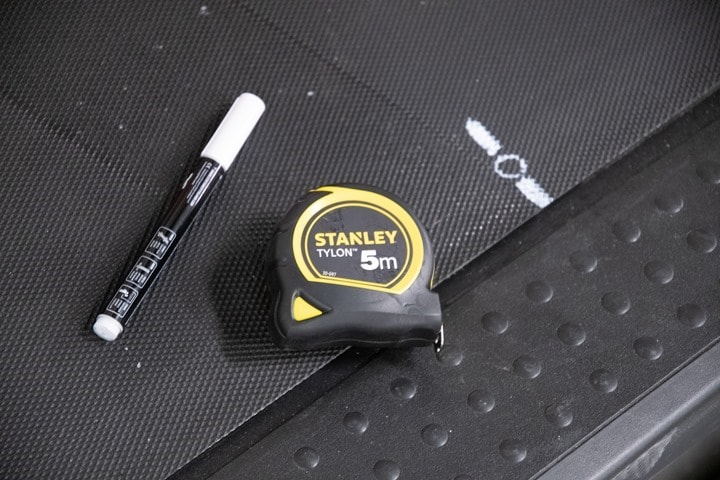
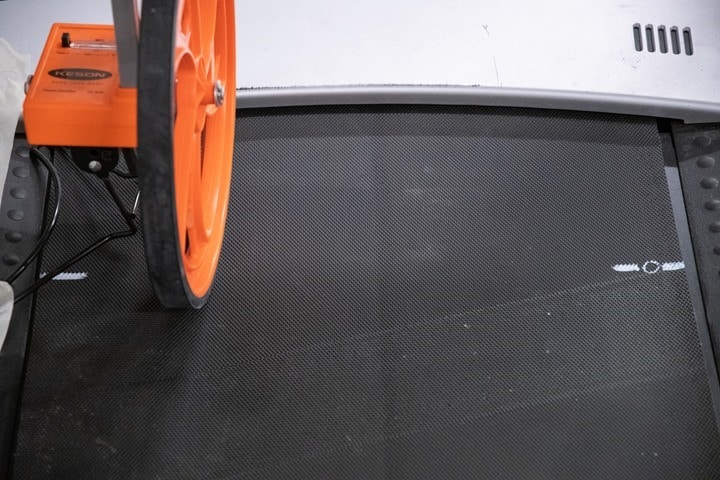
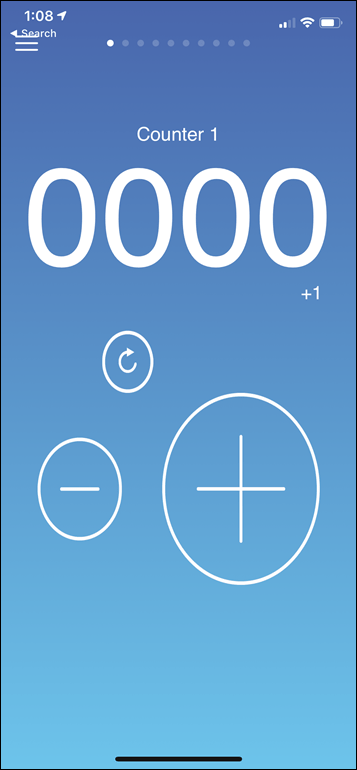
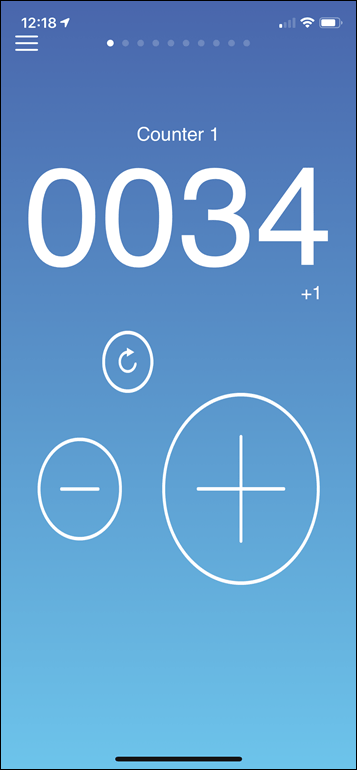
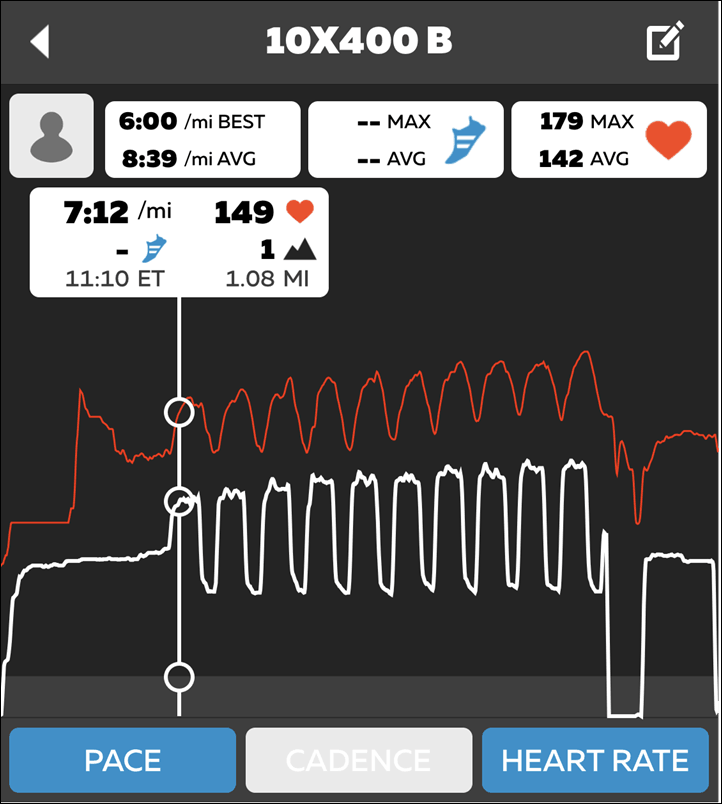



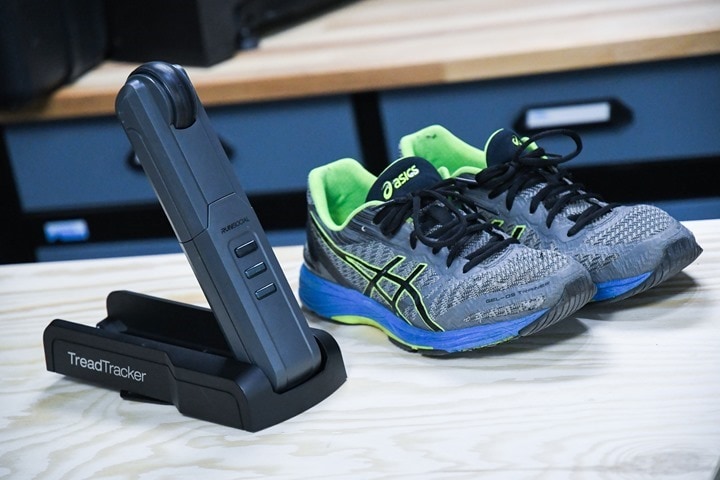
















Does it transmit grade as a metric?
Good point I meant to mention. No, unfortunately no grade is transmitted. 🙁
Good to see. I recall Shane Miller was similarly impressed. I have one too and in a 10K run it matched my MYRUN Technogym treadmill within a few seconds. Current pace can be a little jumpy but, bit like GPS watches, if take a longer view like lap pace then seems a good option. I understand RunSocial actually smooth the pace when you use it with their app so, with that, the pace is rock steady (and yes when you are running). I don’t think Zwift do at present hence my “little jumpy” comment.
Indeed, was impressed with Shane’s accuracy as well.
I suspect the slight jumpiness in the data (at least in my case), is heavily driven by the treadmill just being crap in terms of being able to maintain proper pace itself. And thus carrying through to the TreadTracker as well.
Hey Ray- Any chance you could review some other foot pods when you get around to the Zwift pod? Specially the Garmin foot pod but I’m sure the there are a bunch of wahoos and other brands commonly used. I’m soon to be a treadmill owner so I’m curious about a more price point pod vs the more expensive treadtracker.
I’d love to.
Unfortunately, the footpod market is surprisingly slim. The contenders at present are:
A) Decade old Garmin footpod (ANT+)
B) Stryd footpod+power (dual ANT+/BLE)
C) RunScribe + power (dual ANT+/BLE)
D) Zwift/Milestone pod (BLE)
There used to be Adidas, Sunuto, Timex, Polar, and a few others, but all of them are to the best of my knowledge discontinued. Wahoo unfortunately never made one. Really wish they had, and they oft talked about it too (just re-branding an RPM bike cadence sensor). Finally, Stryd Live was discontinued unfortunately.
Which of the above would you go for if you were going to get one today to pair with a Fenix 5+? I’m thinking the Garmin Foot Pod.
I’m thinking of getting one to use on a treadmill when work travelling.
Cheers
The only problem with the Garmin footpod is that its ANT+ only. So if you plan to use apps like Zwift (especially on iOS), that’s much more difficult.
I wish I had a good answer, but all of them kinda miss the mark slightly (either are overpriced or underfeatured).
Thanks Ray
When you touch base on the Zwift pod, insight into what happens to existing milestone pods would be helpful.
For example, will milestone pods get the same SW updates as the Zwift pods?
Hey Ray,
would we have a review of the Runscribe pods as well? Lots of interesting data there…
Thanks,
Tudor
I’m a long time user of RunScribe – since the initial kickstarter, and then invested on runscribe plus. Footpod accuracy is excellent, and the additional unique gait metrics are fascinating. I’ve not used Stryd, but it seems a lot of money for something that’s really just a pace/cadence footpod (I don’t rate running power as useful – lots of debate on other posts about that!!).
Runscribe isn’t cheap, but it’s probably the most useful running tool I’ve bought.
hey,
i bit the bullet an purchased the runscribe plus as well…and as you’ve said – the correct term is simply fascinating ;-); i was asking about a review because ray tends to be…thorough 😉
GN, what have you changed as a result of using Runscribe, and how has that improved your performance?
In my use of Stryd I can now keep a much more even power output through races, which immediately lead to big PBs for me.
For me, runscribe has helped me monitor my running gait and avoid (or at least predict!) injury. I’ve adjusted my core and strength regime to even up my imbalances, and to give a true measure of how my foot is striking. I transitioned from heel to forefoot, and can now efficiently hammer round the track or cross country in spikes. My 800m interval times during a recent session were massively improved as a result. I’ve gone from 3:46 marathon to 3:38, and 20:00 parkrun to 18:48 (and falling).
Runscribe also provides power and accurate footpod pace – everything that stryd does. I’m not sure, therefore, why anyone would choose stryd over runscribe.
Good luck with your progression! 🙂
hey – as i did comment before on the garmin forums, i found garmin power to be pretty consistent as well; don’t know about accuracy, but i used it for pacing at several marathons and i did a better job by using it to what i would have obtained by using pace or hr; regarding the runscribes – i’m currently sitting at 2:51 and hope to see 2:49…unfortunately it’s been a couple of years now that i’m feeling ‘something’ about my left leg- that one is the first to get tired 😀 – hence i bought the runscribe to see some real life data; as it arrived a month ago and we usually have a pretty harsh winter over here…i didn’t really put it to work, but so far i’m seeing a certain imbalance between the strides, even at slower paces…anyway, what’s 200 usd when you have 3 bikes? 😀
Ha – that’s what I tell Mrs Ginger when I bring home another pair of trainers!! 🙂
😀 – just tell her the real value, in case she decides to sell the whole collection 😀 😀 😀
Unfortunately they’ve been sold out since I started looking for one a couple of weeks ago. They have a link to email for folks who are interested in purchasing one, but it took them a week to reply and gave no indication of when they’ll be available again.
Yeah, I e-mailed them yesterday as well – also sorta wishy-washy answer. Sad panda.
Any update on availability in the UK ? It was our gym’s AGM this morning, and I think I 99% managed to persuade the chair and treasurer to buy a couple… but now cant see how or where they can!
Great article. As others have mentioned, I would also love to see you compare the accuracy of the various footpods (are the cheap ones just as (in)accurate as the more expensive models?). And also share any tips you might have about calibrating those or any other tricks you know to get the most accurate readings.
While I commend your devotion to counting the painted white lines manually, I wonder if you could use a timing light (like the kind use by auto mechanics) to count the revolutions on the treadmill automatically? Just a thought.
Yup, definitely!
Interesting on timing lights – will have to do some research there, that’d be brilliant – especially for higher speeds that’s almost impossible for me to do now (anything beyond about 4KPH is just too prone to error for me).
Slow motion go pro for the faster maths based calcs?
Great review Ray. Like others I would love to see more footpod reviews from an accuracy standpoint. I think the Stryd result in your test is very impressive when you consider it is on only one of two moving feet operating in 3D – but it is SO expensive. It is such a shame they didn’t keep going with the orange one for people who don’t buy in to running with power…. It would be so fantastic if someone could bring out a FP with Stryd accuracy and lack of calibration issues (I have tried various FPs over the years and have struggled to get anything sensible out of others, despite following the calibration steps, whereas the Stryd just works).
BTW, have you separately recorded the BLE ant ANT+ feeds from the Stryd? When I run on Zwift my IOS device records BLE for Zwift and my 935 the ANT+ feed. The average pace is generally a secon per KM different and the pace feed on the BLE much smoother. I wonder whether Zwift smooths the BLE feed?
Best
Chris
Yup, I totally agree that there’s a nice market for an accuracy and reasonably priced footpod. I think the older Milestone pod (at $20-$25) was mostly good for most people. For those that want a bit more accuracy having Stryd Live (the orange one) was a nice step up. But it was too expensive.
I really think $49 is the sweet spot for higher end footpod tech. Beyond that and it’s too niche. Obviously, we could also see the Zwift pod be a bit more accurate with a focus on software algorithms.
I haven’t concurrently recording a Stryd stream in Zwift. Interesting…
It’s not as straight forward as how fast the belt is moving, because this does not factor in the displacement of the runner’s center of mass and the friction upon landing. This friction appears to actually be measured by the Garmin footpod, but not Stryd. The Garmin footpod appears to correlate very well with PE and HR and outdoor GPS (with adequate moving air and fuid intake), while the Stryd varies wildly in terms of pace and power from one treadmill to another, but matches outdoor PE, HR and GPS. I can go from a belt treadmill, to a Woodway, to a Technogym Woodway rip off all in the same time frame and the Garmin pace at the same PE and HR is the same, whereas the Stryd pace and power varies quite a bit. And while the Garmin food pace will remain the same at different grades, the Stryd pace changes at different treadmill grades even though the belt is at the same speed (wearing the Stryd and Garmin simultaneously), but the Stryd power does not change at the steeper treadmill grades, though Stryd works great outdoors on varying grades, with strong correlation to PE, HR and GPS outdoors. Further, I can change my run stride on a treadmill and this changes the Garmin and Stryd paces wildly: long, loping, heel-striking most strongly correlates with the pace Stryd and the treadmill present (Stryd tends to correlate well to the pace displayed on most treadmills) and this type of running stride sees an increase in the Garmin pace. But, a stride with the landing foot landing close to under the center of mass and a quick removal from the ground sees both the Garmin and Stryd reported pace increase, but the Garmin far more so and the Garmin correlates more with PE and HR and outdoor GPS reported pace than does the Stryd. My thought: the moving belt makes removing the rear foot in a timely manner a higher metablic cost that if replicated outdoors would create a higher running speed. To match the timing of the rear foot removal from the ground with the same metabolic cost experienced outdoors while on a treadmill requires the belt move at a slower speed than the pace the runner is “actually” moving at, and this is accompanied by one of two things, if not both of these: less forward displacement of the center of mass and/or more horizontal friction and thus loading force upon landing. The prior leads to more loading of the lower extremities and can lead achilles/plantar fascia issues, and the latter can lead to knee and ankle issues due to the increased loading forces upon the foot landing. Finding the right balance between decreased lean and more friction upon landing to accommodate the slower belt speed due to the relation of rear foot removal to metabolic cost is critical to avoid injury and take advantage of what a treadmill really has to offer: a more controlled environment to really master running mechanics. Just focusing on belt speed, though – in my opinion – is naive.
A lot of speculation here, but I’d agree that treadmill running is not biomechanically IDENTICAL to outdoor running. I do think, however, that the differences are pretty tiny provided that (1) you’re on the right treadmill and (2) you’re extremely experienced at running on a treadmill (which probably means at least 1000 miles).
1) My assumption is that anyone who cares enough about capturing instant pace (in addition to total distance, which can easily be adjusted in Garmin connect after uploading based on the recorded treadmill distance) is also going to care about cadence, which means they would be better served by a cheap $29 Milestone pod.
2) I didn’t see a retail or msrp listed in the review, but perhaps I missed it, but unless it’s cheaper than the foot pod (which also gets you cadence), I think it’s not worth it.
3) Where a device like this could really shine is if it could transmit grade (yes, I understand that there probably isn’t an BLE or ant+ profile for grade, and my Garmin watch can’t record this nonexisting profile (yet…) and then we’re not far from potentially hacking a treadmill to adjust pace/grade automatically to mimic a Zwift course/workout. Relying on external sensor feedback to zwift of the current speed/grade could signal a need to increase or decrease the speed/grade even if the speed/grade was not directly addressable by Zwift. (Someone more skilled than me could probably get this working with computer vision code using a webcam pointed at the zwift screen to read the zwift grade, and then using an arduino to send grade up/down commands to the treadmill control board until the grade matches the grade sensor, or alternatively by calculating the number of grade up/down input signals necessary to meet a certain grade from an initial zero grade value, I.e. the system knows that the grade started at 0% and each button input changes grade by 0.5% or 1%.)
4) and side-note, did you check to see if your treadmill has a hidden calibration setting? If I notice that my treadmill is always long or short to a known distance such as your measuring wheel, I can adjust a calibration factor in a hidden menu on my Sole F85. Perhaps there’s something similar on yours…
link to linkedin.com
To answer my own question, this awesome guy at the linked post already got his Sole F85 controlled by an arduino and created a serial communications setup to allow treadmill control by external software. With this setup, you’d only need to add on the computer vision hardware/software to read the zwift grade and send it to the treadmill!
Related, there is also this for NordicTrack iFit treadmills: link to github.com
Not sure if port 80 is still open in the firmware, will try soon with my non NordicTrack iFit treadmill.
this way to connect to a treadmill? link to dcrainmaker.com
link to smithsonianmag.com
And this article describes using a $10 sonar sensor to determine the runner’s position on the treadmill belt to speed up and slow down the treadmill automatically… (if I can get the previous arduino control, adding the sonar/ultrasonic distance sensor to that seems like it might be possible too… And extra buttons to instantly dial in my favorite running paces…)
Yet, 4 years later in 2019 and we’re still having to hack together these features if we want a more realistic/engaging indoor running experience…
quick clarification: when I wrote that with a long, loping stride my pace increased on the treadmill according to the Garmin footpod, I was being literal with pacing being in units of time: an increase in pace would be a decrease in speed…. so with a long, loping stride on a treadmill, the Garmin reads a slower speed/pace.
You think innacurate distance is bad on a treadmill? Mine gains a whole minute every 20 minutes so the timer doesn’t even match up with my watches! Therefore even if it were driving 10kph correctly and moving the belt exactly 10km the speed would still be wrong because it doesn’t know how long an hour is 🙂
I’d also like to see a deep dive into footpod type tech as some other commentors have suggested. Milesthedog’s comment is particularly interesting because it confirms everything I’ve thought about footpods and running power.
I can see why you may not want to pull at the running pod thread though, the comments will be a nightmare however much evidence and work you put in 🙂
Haha, it’s true – I’ve definitely run on some gym treadmills that didn’t match time. I was all like WTF?!?!
Definitely want to get more into footpod type tech. Obviously, my treadmill accuracy is @$#@, but it’s clear the TreadTracker is actually a pretty good substitute. I wish there was an iPhone app or something that could visually count white lines as they went by.
How about using a magnet-based bike speed sensor instead?
Use duct tape to attach a (sufficiently strong) magnet to the belt, then place the speed sensor near the band so it detects the magnet. In the bike computer / sports watch settings, set the length of the belt as the circumference of the (virtual) bike wheel.
Haven’t tried this myself but I could see this might just work to measure speed and distance. Plus you might just be able to compare the data directly with other sensors using the DCR analyser tool.
That’s an interesting idea. I know I don’t have a ton of clearance coming out of the front plate portion, and I’ve got no idea what happens up near the front roller. I suppose I could probably start off with a bit of Play Dough or a gummy bear stuck to it and see what happens when it goes through.
a bike speed sensor might actually work well here … one could even add additional magnets if one wanted additional granularity of pace info (1 per meter belt for instance) … the wheel size setting would then correspond to belt length.
As you blew past me as I was warming down after the last interval I threw a runners curse, which obviously outed your BLE for the required time for me to get past again. Interesting that your hair is zwift orange ingame, is that a homage to your current home country?
Hahaha!
My hair is technically orange…so…orange too in virtual life!
I’m sure there must be one somewhere! Just been checking out a few apps on Android, and there are lots that work from sound, but there’s one called Magnetic Counter – RPM Meter intended for calibrating turntables that looks like it might be able to be used somehow for this (it counts a magnet passing the phone somehow, presumably like an old skool PM?) If you could affix a magnet to a particular spot on the tread somwehere?
D’oh! That reply was obviously intended for the post above!!
What if you want to do intervals on Zwift ? When you are resting your avatar will be bombing up the road ! Likewise if someone is in a race they might be watching from a chair, with the treadmill cranked to the max!
Mandatory heart rate monitors
There are also other ways people can cheat anyway if they wanted to
Another wrinkle on reported treadmill distance that isn’t accounted for here: Treadmills under load do not move at a constant speed. When the foot is planted, the weight of the runner slows the belt down, and the motor increases its output in order to maintain a constant speed. When the runner is airborne, the motor eases off to avoid going too fast. These adjustments take time, so even if a belt is moving at an average of 9mph, it’s actually moving slowest when you’re on it, and fastest when you’re not. The virtual speed that you experience as a runner will be slower than the actual speed of the belt on average.
link to blog.stryd.com
And thus what’s fun about math – it works no matter what treadmill wonk is going on.
Would be cool to find some sort of optical timing sensor (that I could validate/trust) and get a bit more detailed at higher paces.
I don’t think Math can account for all of the treadmill wonkiness. It seems like the actual running happens when your feet are in contact with the belt. If the belt slows down when your feet are on the belt, and then speeds up when you are airborne, your recorded speed should be the speed the belt is going only when you are in contact with the belt.
In an extreme example (e.g., a treadmill with a lot of slippage), every time you step on the belt it comes to a complete stop, but when you hop, it accelerates to 10mph while you are airborne because there is no load on it.
Just because the belt is moving at 10mph under your feet doesn’t mean that’s how fast you are running at any point (especially since in this example you aren’t running, but hopping in place), but that is how Math, the TreadTracker, and the Orange Counter would all calculate it (obviously it would be something less than 10mph because you’re not hovering, but you get the idea).
It seems like the most accurate method would be to measure your stride is as it relates to the treadmill itself (as opposed to the belt) and and do maths based on that (e.g., 1 meter stride with a cadence of 180 spm = ~6.7mph). You’d definitely need some automated way to make those measurements that unless you have an incredibly consistent stride.
Your math will not help. Read the linked article why.
I was specifically referring to math of the treadmill belt distance – which the maths do work just fine. They don’t account for the footpod side of the equation, or in cases where speed is used to calculate distance.
In the case of a wheel touching it, there’s no measurement of speed, purely distance.
Treadmill distance is relevant only as long as the treadmill is able to keep constant speed when your foot is touching the belt and when it is not. From experience I can say that cheap wobbly treadmills cheat and speed up to catch up. That faster speed (and consequently added distance) is irrelevant and skews effort measurements.
Since speed = distance over time:
speed = (belt length in meters * number of belt revolutions) divided by number of seconds it took to take the measurement = speed in m/s -> multiply by 3.6 to get km/h
This will get you the average speed over the period of time registered.
To have more accurate measurements of speed and distance, one could do what – probably – the TreadTracker does internally. Use a rotary encoder hooked up to a wheel resting on the belt (like the TreadTracker) and have it count how many pulses occur in a certain time frame. The time between the pulses will vary as the belt speeds up / slows down thereby measuring how bad the belt ‘wobbles’. Since the circumference of the wheel is known, the number of pulses per revolution of the wheel/encoder is known and the time is measured, it is trivial to calculate the actual speed, average speed and distance from that… Just takes a bit of tinkering 🙂
Or measure the circumference of the TreadTracker’s drum using the white-line technique and then take a high-speed camera to count the number of times the line passes in a time interval. One could even imagine putting multiple lines on it for more accurate measurements.
But the point is that the speed of the treadmill bed is just a proxy of how fast you would be running should you be making the same physical effort outside. Only the speed of the bed when you are in physical contact with it matters as far as this comparison is concerned. If the speed of the bed is markedly faster than when you are not in contact (ie your impact forces slow it for a few hundred milliseconds when you are in contact), then the average speed of the treadmill is going to be quicker (assuming the treadmill compensates by speeding up again when you are not in contact) than the average estimated ‘speed’ of the runner if that speed is accurately measured by a footpod. Good luck accounting for that! This effect is probably more a factor in cheaper/lighter treadmills?
I suppose its a similar concept to ‘road feel’ on bike trainers – ie the inertial of the flywheel matching the effect of rolling resistance vs the ‘consistency’ of the treadmill bed as it reacts to forces applied by the runner.
I think I’ll get my chalk out and have a look at the ones I tend to gravitate to in the gym!
Any clue where to get one in the states? I’ve been tracking this item for a couple of months and always “sold out” on their website.
I’ve been using an old school ANT+ Garmin footpod and it has been working pretty well with Zwift. One area the footpod lacks is once you try to simulate hills. For at least the Garmin pod, increasing the grade on the treadmill without touching the speed brings the pace reported by the footpod faster (along the lines of link to hillrunner.com, but not quite as significant) This makes trying to “simulate” any hills on Zwift really awkward; For any sense of immersion running hills in Zwift, the pace of the device reported must be similar to the treadmill belt speed regardless of incline since grade is not taken into account in the Zwift running speed calculation.
Ray, have you had a chance (or plans) to test the Wahoo GymConnect module? Seems it could be another, more compact solution for those who don’t trust their footpods. Of course you’d be trusting your treadmill speed more (which as you’ve illustrated isn’t a great idea for those who value accuracy). And isn’t as universally compatible as the TreadTracker. But it does seem to have the added benefit of transmitting (and controlling?) treadmill incline. Thanks
I haven’t.
To the best of my knowledge my treadmill isn’t compatible with it. Though, the NPE guys (who bought it from Wahoo) told me to shoot them the model number, as sometimes there’s less obvious ways to get it working.
Reminds me I need to that…
I have a true ps800 and when i was zwift running (currently not subscribed) it would take the speed and pace directly from the treadmill. While this is really nice it also means your treadmill must be right on. I never had any problems with it. I believe the ps800 has gym connect in it.
The issues with the footpod is how it is calibrated, at what speed it is calibrated, what cadence. If the cadence varies quite a lot from the calibrated one I see big differences between the treadmil and the footpod, either milestone or sorchese rythm. Not even the Garmin Fenix 5 gets closer to the treadmill and this is supposed to have all the data required from outside run and it is supposed to be the best calibrated. I would like to see a test that compares this footpods but without steady interval runs, just run at different speeds, increase, decrease the speed on the fly, just like most of us the beginners do outside.
Any timeline for the scorchese review ?
I’ve found that my Garmin watches get worse for treadmill use (without a foot pod) the more I use them outside. It’s a bit better now that you can do a calibrate and save at the end of the TM run but that calibration changes when I go back outside.
When using a calibrated Garmin foot pod it’s bang on at my normal easy pace +/- 10 seconds per mile but reads fast at faster speeds and slow at slower speeds. Which demonstrates how different I run when on the TM compared to how I run outside.
Hi Ray, wanted to order a Zwift Footpod and ended up with 105,- $ instead of 29,- on the order page. They add delivery and other cost for a delivery to Switzerland and this does not even count for taxes i have to pay when it crosses the border. So Zwift is really not an option on footpods!
That’s nuts.
I was pretty sure it used to be listed on the Amazon UK page until just a few days ago. I remember last weekend going to buy it there, but decided to just wait until I got to the US since by time it came I’d be on a plane anyway.
I’d wait a few more days, or hit up Zwift support to see when they’ll restore the UK side.
Update: Definitely was, here’s the cached link for it as of Dec 31st (29GBP): link to webcache.googleusercontent.com
And here’s the non-active but still there Amazon UK link: link to amazon.co.uk
Hi Ingo
did you buyed ever a footpod somewhere? I’m looking for a footpod as well, but it’s quite difficult here in switzerland!
The best option I found is the TICKR X strap from Wahoo by Ebay. Or if you go to a trainingcamp on the canary islands send the items to the hotel 😉 But up to now, I haven’t buyed any,
I have done Similar to Calibrate my Garmin foot pod for when I am forced to use treadmill because of inclement weather. (My tests were at much slower pace.) I used a small magnet siliconed to belt, measured belt length, Hall effect sensor module and an Arduino pro-mini microprocessor communicating by serial connection to my computer. This is very accurate (more so that what treadmill says). I used the distance from my measurements to arrive at Calibration Factors as follows:
Treadmill Jog CF 110.3
Treadmill Walk CF 95.7
Treadmill Interval (Ranging between 5.7 to 7.5 KPH) CF 107.3
n.b.
1. A second Garmin footpod and a Myfit pod [Milestone] gave similar results.
2. I do not let my Garmin Foot pod auto calibrate.
ok this is kind of cool in a completely geeky way. I find that on the TM my garmin foot bod think I am running 45 Sec FASTER per mile… it is great when my coach thinks I just did 10 miles at a 6:30 pace but it isn’t real… and the calibrate function of the Fenix doesn’t go down in miles… I guess it assumes only up
I went with an optical sensor, white paint mark, and an NRF52840 dongle to build a treadmill “footpod” to broadcast distance and pace right to the watch via ANT+.
Saw similar results to what others described. Unloaded, the treadmill belt moved considerably faster than the displayed speed. Loaded, the belt speed was closer to the display, but still faster.
Either way, the reported distance and pace is now much closer to what the treadmill says than what the watch’s internal accelerometer comes up with.
Great idea. Since my response #64 I now send arduino serial data for distance straight to an excell spreadsheet every second with PLX-DAQ. I have trialed both the Garmin and Milestone (Badged as MyFit here in Australia) POD’s and confirmed the Milestone follows My measured treadmill pace more reliably. (Attached graph). My next step was to get this onto my Garmin Fenix 3 HR. You have already done this. Would appreciate your build and coding details. Ray might approve of us communicating direct by email. I will ask him.
Yes! Please write this up!
I’ve been all over the Internet looking for an old nrf24ap to try and get ant+ working with an esp8266 or esp32, but I saw they have some nrf52840 development boards now that can run micropython, which I’ve been using to get an ultrasonic distance sensor working to automatically adjust my treadmill speed based on my position on the belt (start running faster and farther forward speeds up and vice versa). Hoping to document my process as I finish up. All of the wiring/soldering on my treadmill is completed, and this afternoon I got the software and relays (start/stop/faster/slower/incline up/down) completed but there will be tuning and other issues when I get on the treadmill.
After speed is working, my plan is to adjust grade based on in-game Zwift grade using the zwift-client Python library. Would love to hook relays up to my cheap $15 three-tiered fan and adjust speed based on hr/power or “cave” temperature/humidity either through ant+ or the values from the zwift-client,to create a poor man’s Wahoo Wind…
Indeed, I’d love to see this written up somewhere! Here, there, anywhere!
I’m definitely planning a full write-up of all of this and I’ll share the code and as much of the compiled binary as the ANT+ agreement lets me. I’m still tweaking the code to work through some slight oddities I’m seeing while masquerading under the ANT+ SDM (foot pod) spec since I don’t really know the cadence or strides. Last Sunday was my first long run with it on the treadmill and it’s just about there.
The very short version is that it uses an NRF52840 dongle (around $10 US) and a variable distance optical obstacle detection board (about $1 US) to trigger an interrupt every time a white mark on the belt is seen. I put one paint mark on the belt (originally started as tape but they got spit off every time at various distances). I measured the belt similar to how Ray mentioned above. Knowing the belt length, each time mark is seen I increment the distance by the belt length and recalculate pace using time elapsed between the last seen mark and the current mark. The code started with porting the SDM Tx example in the Nordic SDK to the NRF52840 dongle and it uses the S212 SoftDevice for ANT+.
How about adding a microphone sensor and using the spike in noise passing a certain threshold from each foot-strike to get cadence?
That’s an interesting idea. While I was waiting for the NRF board to show up I was doing some testing with an Arduino an the GY-521 accelerometer/gyro dev board to see if I could I identify foot strikes through vibrations in the treadmill with the setup roughly where I planned on putting the optical sensor. The foot strikes did stand out versus the general noise/vibration that the treadmill produced, so I think it could be done.
I was kind of hoping to get the best of both worlds. Have my “foot pod” sensor report distance/pace and have the watch fall back to its internal accelerometer for cadence tracking. In the capabilities page of the SDM ANT+ data I report that cadence is not valid but the watch (Garmin Vivoactive 3 Music) never requests the capabilities page and it also doesn’t appear to use its own accelerometer (at least for the recorded activity) if a foot pod is present. Interesting enough, it does seem to still be internally counting footsteps as I’ve gotten the goal message during an activity.
A full write up of the project is going up as a series of blog posts at link to treadmillsensor.blogspot.com. First post is up and I’ve got a few of the others written as drafts.
Code is at link to github.com. The blog posts will eventually catch up and have a link to the code as well.
Thanks Jonathan! Looking forward to seeing more of the build writeup. Any chance you can post your Python code to your github site from your raspberry pi proof of concept too?
Still fighting some memory issues on my 8266 “auto treadmill” but hopefully can write something up soon!
Sure thing: link to github.com
All the posts are up for now. There should be enough there from the way-too-technical how to duplicate what I did, to the subtle nuances I saw in my watch’s behavior in certain situations.
The posts are at: link to treadmillsensor.blogspot.com
The code is at: link to github.com
David, I think you could probably just swap out my IR sensor with your hall effect sensor and maybe tweak the interrupt code slightly depending on how that signal is reported (Not sure if it’s a digital or analog value). Other than that, the rest of the code should work as is.
I kind of wish that I saw that siliconing onto the belt held the magnet before I got started, I probably would have gone that way instead of IR. It’s definitely less noticeable than my white stripe of paint on the belt.
Our requests for Jonathan’s write up materializing on blogspot and github is very much appreciated by myself and I am sure others. There is no way I would have been able to program from scratch myself. Thanks.
The bullet no 4 under “Ok, so at this point I’d summarize things as follows:” – that the TreadTracker with watch to record is within 0.5 % – does not fully align with the results, unless the 100.0 m for TreadTracker in the second 100m-test (using Garmin watch) should say something other than 100.0 m. (It may also be the case that I misunderstand, but I’ve read that section several times now)
Yeah, somehow on that 4th bullet I started a thought and then apparently finished with another one. Fixed it.
I’m already looking forward to finding one of these waiting for me under a gym treadmill. Wait, I meant under a Christmas tree. Yeah, Christmas tree.
I’m looking forward to your test of the Zwift RunPod since I’ve not been able to get mine to work. Part of it may be that I’m not really running. I mostly walk in the 3-5 mph range as a cool down after I ride. The RunPod just doesn’t want to calibrate at these lower speeds and even if I manage to get it to calibrate at higher speeds it’s wildly out of wack with my Landice treadmill and will not show any movement in Zwift until I pick up the pace.
By contrast, all works just fine with my Wahoo TICKR X. Speeds are much closer and Zwift actually shows some movement even when I’m not moving. That’s not right either but it is better than the alternative.
“Obviously Stryd’s pod does power and other things, but most people don’t care about that.” — yes, in the same way cyclists don’t care about power ?
Stryd doesn’t “bounce around” in terms of pace, as your own testing above shows. In fact the take-away from this article seems to be how accurate Stryd is.
I’m referring to the larger population of runners, which overwhelmingly don’t care about running power.
I’ve argued repeatedly that Stryd is essentially slow-blowing any advantage they have adoption wise by keeping prices so high. It’s only a matter of time before everyone follows Polar and running power becomes commodity.
I’m saying similar above – why buy stryd for power, when you can buy runscribe for dual sided power and dual sided gait metrics?
I honestly don’t understand stryd’s thinking and they risk being made redundant at that price.
I run on one of those fancy Woodway treadmills. Any idea how the TreadTracker works on Woodways or other treadmills that use slats instead of a smooth belt as a running surface?
Many thanks for an interesting article – I use a footpod with Zwift on a number of treadmills at a couple of gyms and have been interested in trying to get a more accurate speed/distance as I can see the limitations of both pod and treadmill. I seem to have come to a separate conclusion to the article based on the same results you have provided and want to, please, check I have understood them correctly?
– In most of the results it appears the math distance and the Orange counter are near identical (this does not surprise me given those type of Orange counters are usually calibrated at the factory and the tyre on the wheel probably hasn’t worn down much since then). Given that, I’ll take either of those two measurements are “base” case.
– If I then take the variation of the TreadTracker from that “base”, it is not that much better than your treadmill. The Tread Tracker on the 1000m tests was around 25m less than “base” and the Treadmill around 30m more than “base”. Other distances seems to show similar % variations with the Tread tracker 2.5% lower and the treadmill 3% higher.
– You describe your treadmill as not very good.
Given the TreadTracker is only about as accurate (okay maybe 0.5% better) than a not very good treadmill, why would I spend $200 on it? I may as well take speed/distance of the treadmill given its roughly the same level of inaccuracy?
At $200 I would have expected the TreadTracker to have been at least as accurate in distance terms as the Orange Counter, unless I have misunderstood the results? Given that it deviates away suggests it either (i) doesn’t maintain as a good contact/tracking of the belt as the orange counter Or (ii) isn’t properly calibrated Or (iii) has a software issue reporting the right distance to the recording devices.
One other thought on the accuracy of the TreadTracker…given its fairly small wheel, any deviation from being exactly 100% parallel with the belt would give an inaccurate result? …and notably it would be less than true distance recorded.
Another potential source of speed/distance measurement is to strap your bike (or just a front fork) to it with a regular ANT+ speed sensor! As long as you measure the wheel’s circumference accurately you should get good figures.
Or how about fixing a magnet to the belt and using an old fashioned magnet activate speed sensor?
How is this any better than the optical/magnetic sensor that is built in to the treadmill?
My guess would be that a properly placed belt magnet might be a better ‘known good’, whereas a treadmill may be placing a magnet/sensor on another upstream piece (such as a motor that has a smaller circumference) that could be out of alignment (or definitely is, as seen here).
That makes sense. Taking a measurement anywhere other than the belt will add some error.
But I’d think that adding an optical or magnetic pickup on the mat would be more accurate and subject to a lower failure rate than a mechanical contact wheel.
My apologies to David Warren – he was clearly ahead of me with the magnet thought and took it much further.
No worries David. I confirm the methodology workes well. Allowed me to use the lower priced Footpod with an accurate calibration factor for treadmill walking/Jogging. It is my experience that these units have very limited capacity to cope with changing Gaits at slow paces. This is easily observed by viewing real time Footpod pace with different gaits and constant treadmill speed. This is what first alerted me to the issue.
Just stumbled across this, I agree, a non mechanical sensor seems better. however i dont know if the belt expands after warm up etc resulting in calibration drift… anyway something paired with a bluetooth/ant+ pitch sensor, could produce climb rate too….
Hey Paul,
I used an optical mark on the belt with the treadmill speed sensor I came up with. I’m not sure about the belt expanding as it warms up, I never thought to measure it before and after a run. In my experience, though, the treadmill belt seemed to get faster as time went on. I dug into it a little while wearing the Running Dynamics HRM and I think that in my case the speed up was due to less ground contact time with the belt.
I wrote it up at link to treadmillsensor.blogspot.com
Jonathan
Hi Ray !
I bought a treadtracker last year, it lasted a couple of time before not charging. I had a chat with customer service and they sent me a brand new one without asking the old one back.
I received the second one, used it twice and then the same thing, the unit was not charging. I contacted them again and they reinbused me since they didn’t have any to send me back at the moment. The customer service is incredible ! The product … well I’m a bit dissapointed.
While I was using it I found it perfect ! Speed was spot on. Only drawback is that since it’s bluetooth, I can’t send the data to my garmin 935 and my computer with Zwift, I have to choose.
Someone had the same problems or am I the only one ?
Hi snowfree52!
Did I understand correctly that it is not possible to pair the TreadTracker in parallel with the Garmin 935 and Zwift?
Basically, it would be possible with Bluetooth.
Nope.. looks like Bluetooth only and therefore only one client. You would need something to bridge the bluetooth to Ant+
I use a milestone pod and am wondering how the zwift run calibration interacts with the pod calibration? i.e. there’s a milestone app that calibrates the pod. If you then do the zwift calibration, which one is being used?
I believe the calibration is loaded on to the pod. So the most recent calibration is the one being used regardless of the app used. But I could be wrong. 🙂
I have comfirmed with milestone that their calibration from their App is loaded onto Pod. To reset pod without calibratation take out Battery and reinsert. Do not sync with their app. I have also confirmed with Wahoo that their calibration factor only works within their app. I do not know for zwift as I do not use that App.
If anyone knows where I can purchase one of these (out of stock at run social), please let me know.
Thanks….
Where do I buy one of these? They seem to be impossible to find and are such a great idea
Ray,
I think you have to check this site:
link to healthpremiere.org
Do you have copyright on your articles?
:-s
Which is more accurate as far as distance and pace are concerned when running on the treadmill… the stryd footpod or the treadtracker?
Hi everyone, Are you into trading or just wish to give it a try, please becareful on the platform you choose to invest on and the manager you choose to manage your account because that’s where failure starts from be wise. After reading so much comment i had to give trading tips a try, I have to come to the conclusion that binary options pays massively but the masses has refused to show us the right way to earn That’s why I have to give trading tips the accolades because they have been so helpful to traders . For a free masterclass strategy kindly contact maryshea03@gmail.com for a free masterclass strategy. She’ll give you a free tutors on how you can earn and recover your losses in trading for free..
Hello everyone , here’s your opportunity for you to achieve your dreams of being a multi million dollar rich through trading , I once loss all I got through trading but was fortunate to come across a woman with great virtue and selfless heart (Mary ) i was introduce to her masterclass strategy while searching online which has revived me of all my losses and made me gain more and more . With her unique strategy you are entitled to daily signals and instant withdraw ,be rest assured of getting a refund of all your loss investment with any platform that has denied you in one way or the other in getting your money . Mrs Mary masterclass strategy is simply the best for beginners and those that are finding it difficult to succeed through trading she’ll help you with just a simple step . Email her ( maryshea03 @ Gmail .com) WhatsApp +1 562 384 7738 . Remember this is absolutely free!!!
Nothing frustrates me more than gym treadmills which are so far off calibration it’s useless to record the distance. The other is the complete lack of accuracy of my Garmin with Tri-HRM on a treadmill. Are there any products which can tell you true treadmill speed?
Apparently this TreadTracker is no longer being made.
However us Zwift Runners are awaiting with some interest the imminent release of the Runn link to npe-inc.com which appears to do very similar things but all wirelessly so no direct contact of a wheel to measure your belt speed.
That looks a lot like a more productized version of what I built earlier this year, minus ANT+ and with Bluetooth instead.
https://treadmillsensor.blogspot.com
It looks like they may have gone with an optical sensor as well and found a sticker that will actually stay stuck to the belt. The user guide discusses applying a sticker to the belt:
link to npe-inc.zendesk.com
They don’t mention measuring the belt length, so I’m guessing they’re going to adjust for it via an offset value when you calibrate it to match what the treadmill said the distance was. On one of the pages in the blog I dug a little deeper into how I thought my treadmill was reporting the distance incorrectly. I’d also wonder about moving it from treadmill to treadmill if taking it to a gym if it was calibrated to match a particular treadmill’s reported distance.
Very cool to see something like this being produced.
Just ordered it
Thanks for the link
Just ordered one also….
I have wanted one of these for a while, and have finally come around to justify buying it. I see now that it’s available, but discontinued. What’s your thoughts on this Ray?
Look at the NPE RUNN: link to npe-inc.com
Oops! I realize now the Runn sensor was the one I was looking for, not this! I’d read your review of that, but forgot about it! I ordered the Runn sensor!
You mentioned a Connect IQ app to indicate the distance in meters. While it is true that Garmin Connect only display the distance in steps of 10 meters (e.g. my last run was 11.52km), it stores it with more digits in the FIT file. You can download the FIT file and open it on http://www.fitfileviewer.com to see exactly what is in it. In this case, the distance was 11517.53m, in steps of 1cm! Obviously, in daily practice, these digits are not relevant since measuring is not that accurate, but for calibration it makes sense.
Have you or anyone tried this with a slatted rather than a belt treadmill?